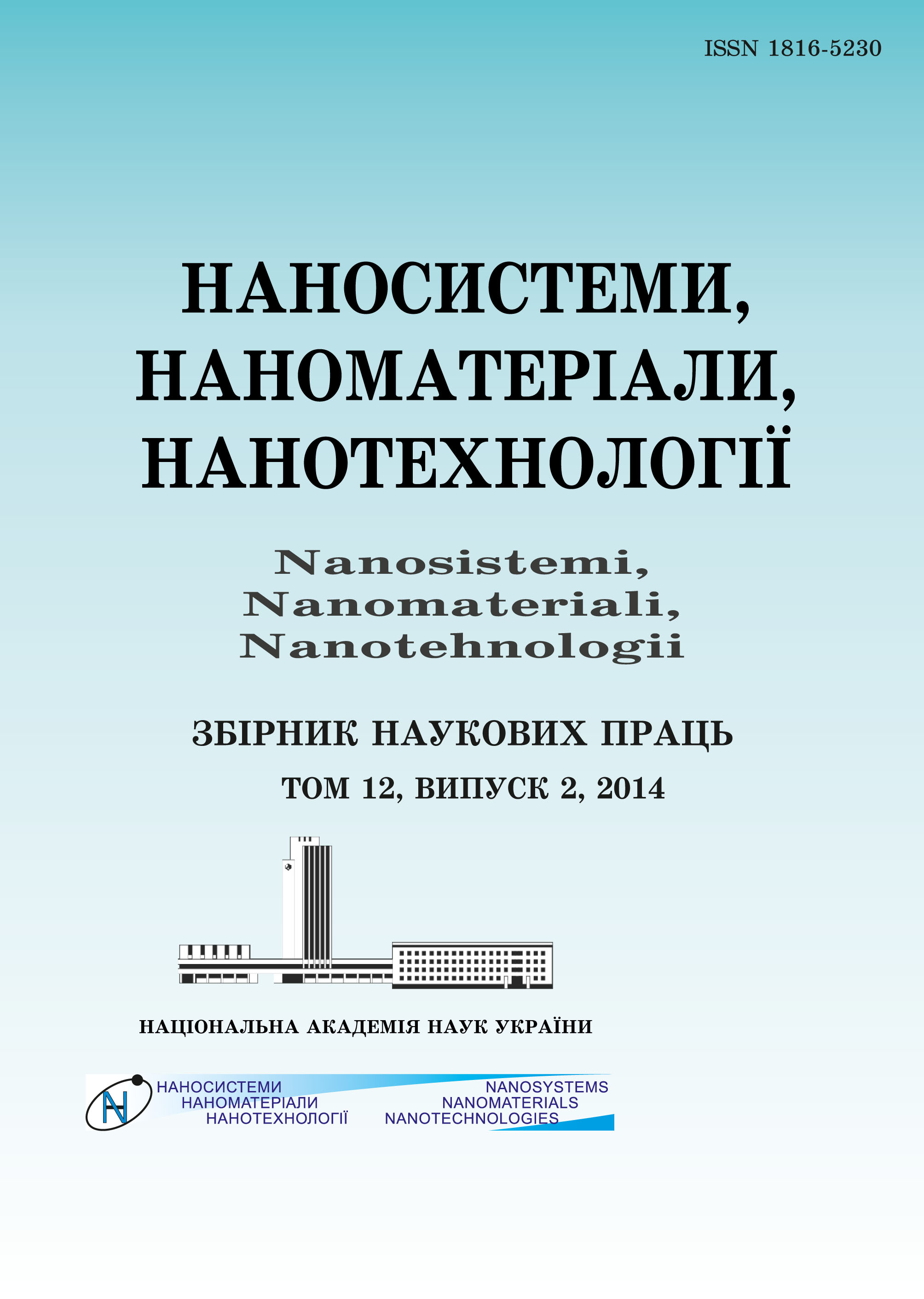|
|
|||||||||

|
Year 2024 Volume 22, Issue 1 |
|
|||||||
|
|||||||||
Issues/2024/vol. 22 /issue 1 |
|
O.V. ZINCHENKO, V.D. EZHOVA, and A.L. TOLSTOV
Structure and Photochemical Characteristics of
Hybrid TiO2/SiO2/Wollastonite Catalysts Prepared via Sol-Gel Approach
67–84 (2024)
PACS numbers: 61.80.Ba, 61.82.Rx, 77.84.Cg, 78.67.Rb, 81.16.Pr, 81.20.Fw, 82.50.Hp
Photoactive TiO2/SiO2 composites are fabricated via in situ sol–gel approach by deposition of as-prepared mixture of orthotitanic (TiO2•xH2O) and orthosilicic (SiO2•yH2O) acids onto a surface of micronized natural mineral CaSiO3 (wollastonite) followed by their condensation. Thermal treatment of the raw composite layer activates deep condensation of orthoacids and leads to the formation of nanostructured composite materials. Using SiO2 precursors, namely, organosilicon compounds and potassium silicate playing the role of binders and structure modifiers of ТіО2 phase, provides the formation of hybrid-powdered catalysts. The hybrid structure of the composite catalysts is considered by FTIR spectroscopy. The results of WAXS demonstrate an appearance of nanocrystalline ТіО2 anatase phase with crystalline phase content of up to 70%. Porosity measurements of the composites show a formation of nanostructured materials with well-defined microporous structure, which is characterized by surface area in the range of 60–225 m2•g–1 and micropore volume of 2–30 mm3•g–1. Evaluation of efficacy of produced composite photocatalysts in laboratory conditions under the dynamic regime and irradiation by UV-light as well as in environmental conditions in the static regime and under irradiation by direct solar light or scattered daylight demonstrate high photochemical activity in the oxidation reaction of methylene blue (MB) and nigrosine dyes. The photocatalysts are characterized by a high degradation rate (vav) of MB dye under UV-illumination that reaches 7.2 µmol•g–1•hr–1. Testing the photocatalytic coatings fabricated by spray-drying approach of powdered catalysts on inert substrate demonstrates appropriate activity as well. The degradation rate (vav) value of the coatings under direct solar-light illumination reaches 0.115 nmol•cm–2•day–1 (for MB dye) and 0.06 nmol•cm–2•day–1 (for industrial nigrosine dye). Thus, the results evidence of perspectives of practical uses of produced photocatalysts for manufacturing of cartridges for purification and decontamination of wastewater as well as for producing self-cleaning coatings for internal and external uses
KEY WORDS: ТіО2, wollastonite, composites, structure, properties, photocatalytic decontamination
DOI: https://doi.org/10.15407/nnn.22.01.067
REFERENCES
- X. Chen and S. S. Mao, Chem. Rev., 107: 2891 (2007); https://doi.org/10.1021/cr0500535
- K. P. Gopinath, N. V. Madhav, A. Krishnan, R. Malolan, and G. Rangarajan, J. Environ. Manag., 270: 110906 (2020); https://doi.org/10.1016/j.jenvman.2020.110906
- O. L. Stroyuk and S. Ya. Kuchmy, Theoret. Experim. Chem., 56, No. 3: 143 (2020); https://doi.org/10.1007/s11237-020-09648-0
- C. Liu, Y. Li, and Q. Duan, Appl. Surf. Sci., 503: 144111 (2020); https://doi.org/10.1016/j.apsusc.2019.144111
- N. I. Romanovska, P. A. Manoryk, N. I. Ermokhina, P. S. Yaremov, and V. M. Grebennikov, Theoret. Experim. Chem., 55, No. 5: 345 (2019); https://doi.org/10.1007/s11237-019-09627-0
- V. F. Matyushov, A. L. Tolstov, P. S. Yaremov, and V. G. Ilyin, Theoret. Expim. Chem., 49, No. 5: 333 (2013); https://doi.org/10.1007/s11237-013-9334-6
- M. Zhang, E. Lei, R. Zhang, and Z. Liu, Surface Interfaces, 16: 194 (2019); https://doi.org/10.1016/j.surfin.2018.10.005
- K. Guan, Surface Coat Technol., 191: 155 (2005); https://doi.org/10.1016/j.surfcoat.2004.02.022
- K. Balachandaran, Int. J. Eng. Sci. Technol., 2, No. 8: 3695 (2010); http://www.ijest.info/docs/IJEST10-02-08-66.pdf
- Z. Bielan, A. Sulowska, S. Dudziak, K. Siuzdak, J. Ryl, and A. Zielinska-Jurek, Catalysts, 10: 672 (2020); https://doi.org/10.3390/catal10060672
- S. Varnagiris, M. Urbonavicius, S. Sakalauskaite, R. Daugelavicius, and D. Milcius, Sci. Total Environ., 720: 137600 (2020); https://doi.org/10.1016/j.scitotenv.2020.137600
- E. Loccufier, K. Deventer, D. Manhaeghe, S. W. H. Van Hulle, and K. De Clerck, Chem. Eng. J., 387: 124143 (2020); https://doi.org/10.1016/j.cej.2020.124143
- Q. Li and F.-T. Li, Adv. Colloid Interface Sci., 284: 102275 (2020); https://doi.org/10.1016/j.cis.2020.102275
- E. I. Cedillo-Gonz?lez, J. M. Hern?ndez-L?pez, J. J. Ruiz-Vald?s, V. Barbieri, and C. Siligardi, Construct. Build. Mater., 237: 117692 (2020); https://doi.org/10.1016/j.conbuildmat.2019.117692
- A. Matsuda, T. Matoda, and T. Kogure, Chem. Mater., 17: 749 (2005); https://doi.org/10.1021/cm048135h
- N. Negishi, M. Sugasawa, Y. Miyazaki, Y. Hirami, and S. Koura, Water Res, 150: 40 (2019); https://doi.org/10.1016/j.watres.2018.11.047
- E. P. Ferreira-Neto, M. A. Worsley, and U. P. Rodrigues-Filho, J. Environ. Chem. Eng., 7, No. 5: 103425 (2019); https://doi.org/10.1016/j.jece.2019.103425
- G. J. Rinc?n and E. J. La Motta, Heliyon, 5, No. 6: e01966 (2019); https://doi.org/10.1016/j.heliyon.2019.e01966
- D. Wang, P. Hou, D. Stephan, S. Huang, and X. Cheng, Construct. Build Mater., 241: 118124 (2020); https://doi.org/10.1016/j.conbuildmat.2020.118124
- I. Fatimah, N. I. Prakoso, I. Sahroni, M. M. Musawwa, and O. Muraza, Heliyon, 5, No. 11: e02766 (2019); https://doi.org/10.1016/j.heliyon.2019.e02766
- A. S. Yusuff, I. I. Olateju, and O. A. Adesina, Materialia, 8: 100484 (2019); https://doi.org/10.1016/j.mtla.2019.100484
- V. Wongso, C. J. Chen, A. Razzaq, N. A. Kamal, and N. S. Sambudi, Appl. Clay Sci., 180: 105158 (2019); https://doi.org/10.1016/j.clay.2019.105158
- H. Xie, N. Li, B. Liu, J. Yang, and X. Zhao, J. Phys. Chem. C, 120, No. 19: 10390 (2016); https://doi.org/10.1021/acs.jpcc.6b01730
- M. E. Kurtoglu, T. Longenbach, and Yu. Gogotsi, Int. J. Appl. Glass Sci., 2, No. 2: 108 (2011); https://doi.org/10.1111/j.2041-1294.2011.00040.x
- S. Sanna, W. G. Schmidt, and P. Thissen, J. Phys. Chem. C, 118: 8007 (2014); https://doi.org/10.1021/jp500170t
- C. Paluszkiewicz, M. Blazewicz, J. Podporska, and T. Gumu?a, Vibrat. Spectr., 48: 263 (2008); https://doi.org/10.1016/j.vibspec.2008.02.020
- A. M. Hofmeister and J. E. Bowey, Mon. Not. R. Astron. Soc., 367: 577 (2006); https://doi.org/10.1111/j.1365-2966.2006.09894.x
- V. A. Zeitler and C. A. Brown, J. Phys. Chem., 61, No. 9: 1174 (1957); https://doi.org/10.1021/ac60132a615
- A. Burneau, O. Barres, J. P. Gallas, and J. C. Lavalley, Langmuir, 6, No. 8: 1364 (1990); https://doi.org/10.1021/la00098a008
- B. Brem, E. Gal, L. G?in?, L. Silaghi-Dumitrescu, E. Fischer-Fodor, C. I. Tomuleasa, A. Grozav, V. Zaharia, L. Filip, and C. Cristea, Int. J. Mol. Sci., 18: 1365 (2017); https://doi.org/10.3390/ijms18071365
 This article is licensed under the Creative Commons Attribution-NoDerivatives 4.0 International License ©2003—2024 NANOSISTEMI, NANOMATERIALI, NANOTEHNOLOGII G. V. Kurdyumov Institute for Metal Physics of the National Academy of Sciences of Ukraine. E-mail: tatar@imp.kiev.ua Phones and address of the editorial office About the collection User agreement |